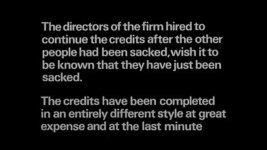USCHO Fan Forum
-
The USCHO Fan Forum has migrated to a new plaform, xenForo. Most of the function of the forum should work in familiar ways. Please note that you can switch between light and dark modes by clicking on the gear icon in the upper right of the main menu bar. We are hoping that this new platform will prove to be faster and more reliable. Please feel free to explore its features.
You are using an out of date browser. It may not display this or other websites correctly.
You should upgrade or use an alternative browser.
You should upgrade or use an alternative browser.
Dump Term 2 Part 3: "But I Say Unto You, Hate Thy Enemies." -- Revulsions 5:44
- Thread starter Kepler
- Start date
Handyman
Hug someone you care about...
The Tennessee Holler (@thetnholler.bsky.social)
“Will you release all the files within 30 days?” BONDI: “We’ll continue to follow the law.”🤔 “You said no addition investigation was warranted. What changed?” BONDI: “Information.” 🙃
Christ will someone get Ditzy McSuckedOffOrangey a script...
Kash wants to be anywhere but there. I think he knows he is going to be the patsy.
Handyman
Hug someone you care about...
Jason Campbell (@jasonscampbell.bsky.social)
Ben Shapiro: “When the president said deport all the illegal immigrants, I never thought that he meant that literally”
We did...and that is why we are smart and you are the nerdy kid we beat up at Hebrew School.
(Its also why you are going broke and phuckwits like Candace Owens is cleaning your clock)
Handyman
Hug someone you care about...
Go Back To Insurance Law
by David Kurtz
11.19.25 | 12:21 pm
WASHINGTON, DC - MARCH 6: Lindsey Halligan, attorney for U.S. President Donald Trump, holds cer... MORE
Share
15
ALEXANDRIA, VA—In a stunning admission, prosecutors in the James Comey case conceded that the two-count indictment against the former FBI director was never presented to or voted on by a grand jury.
The paperwork snafu that has bedeviled the case from the beginning came into much sharper focus after persistent questioning from U.S. District Judge Michael Nachmanoff in federal court Wednesday in Alexandria, Virginia.
At issue is whether U.S. Attorney Lindsey Halligan — an insurance lawyer with no prior prosecutorial experience — followed proper procedure after the grand jury rejected count 1 of the original proposed indictment it was given.
The prosecutors in the case on Wednesday for a time turned into witnesses as the judge pressed them for details on what had happened in the late afternoon of Sept 25, 2025. After extensive back and forth, including hauling Halligan herself to the podium (she has not spoken in any substantive way in open court in the case before today), prosecutors conceded that the draft of the operative two-count second indictment that the case has been proceeding based on was never presented to nor voted on by the grand jury.
Instead, Halligan and the grand jury foreman and another grand juror presented both the rejected indictment and the revised indictment to a magistrate judge, who noted some of the incongruities and tried to clean up the mess. Different ink used on the two indictments was among the early clues that things might be amiss, and Nachmanoff noted the ink disparity in court today.
What was on open question until today was whether the grand jury as a whole had ever considered the revised version of the indictment. Ironically, the issue was resurfaced again by Halligan herself on Friday, when she filed a declaration in the case saying she had had no further contact with the grand jury after presenting it with the original three-count indictment. The declaration was filed in response to concerns raised by another judge considering Comey’s challenge to the validity of Halligan’s appointment as U.S. attorney, but it caught the eye of Nachmanoff.
The stunning courtroom disclosure — cinematic in its intensity — came in a hearing ostensibly to hear Comey’s motion to dismiss the case on the grounds that it is a vindictive and selective prosecution. That portion of the hearing went very poorly for the government, too, but it was overshadowed by the revelation that there may have been no indictment at all.
The implications of the apparent screw up aren’t immediately clear, but they are potentially catastrophic to the government’s case. The statute of limitations on the charges against Comey expired shortly after the purported indictment was secured. So if the case against Comey is dismissed — or, more precisely, if the case never existed — then the government may not be able to refile charges against him.
Nachmanoff ordered the parties to brief him immediately on the implications of the revelations that the indictment may not be legitimate. In particular, he pointed them to a 1969 case from the D.C. Circuit Court of Appeals.
ScoobyDoo
NPC
Ben Shapiro. A stupid man who makes content for other stupid men.
Jason Campbell (@jasonscampbell.bsky.social)
Ben Shapiro: “When the president said deport all the illegal immigrants, I never thought that he meant that literally”bsky.app
We did...and that is why we are smart and you are the nerdy kid we beat up at Hebrew School.
(Its also why you are going broke and phuckwits like Candace Owens is cleaning your clock)
FadeToBlack&Gold
Microlot Marxist
Bet she was all excited about playing a real, big girl lawyer in court. Oops!
Handyman
Hug someone you care about...
She thought Legally Blonde was a documentary...Bet she was all excited about playing a real, big girl lawyer in court. Oops!
These people make Jenna Ellis look smart
Handyman
Hug someone you care about...
Aaron Rupar (@atrupar.com)
Trump on Jerome Powell: "I'd love to fire his ass. He should be fired. The only thing Scott [Bessent] is blowing it on is the Fed. The rates are too high, Scott. And if you don't get it fixed fast, I'm going to fire your ass."
Handyman
Hug someone you care about...
Anna Bower (@annabower.bsky.social)
MORE: Under questioning by the judge, prosecutor Tyler Lemons said that he’s under orders from the Deputy Attorney Generals’s office not to disclose whether there is a declination memo recommending against the prosecution of Comey
These people are so good at their jobs...
French Rage
NICKERSON HAS [CENSORED]

Aaron Rupar (@atrupar.com)
Trump on Jerome Powell: "I'd love to fire his ass. He should be fired. The only thing Scott [Bessent] is blowing it on is the Fed. The rates are too high, Scott. And if you don't get it fixed fast, I'm going to fire your ass."bsky.app
I'm going to fire the guy I hired for not firing the guy I hired.
ScoobyDoo
NPC
Harry Litman (@harrylitman.bsky.social)
HUGE development IN hearing for Comey selective prosecution motion, It turns out that the grand jury NEVER saw the operative indictment. Whole separate basis for dismissal. Standby for more.
The stupidest hired the stupidest to do the stupid.
French Rage
NICKERSON HAS [CENSORED]

Harry Litman (@harrylitman.bsky.social)
HUGE development IN hearing for Comey selective prosecution motion, It turns out that the grand jury NEVER saw the operative indictment. Whole separate basis for dismissal. Standby for more.bsky.app
The stupidest hired the stupidest to do the stupid.
How is someone that incompetent?
I expect more from someone wearing a bikini on an episode of "South Beach Tow".
ScoobyDoo
NPC
I dunno but I didn't go to law school and I could have done a better job.How is someone that incompetent?
I expect more from someone wearing a bikini on an episode of "South Beach Tow".
Handyman
Hug someone you care about...
Do you have me blocked...you keep posting about what I post like 2 hours later like its new info
Harry Litman (@harrylitman.bsky.social)
HUGE development IN hearing for Comey selective prosecution motion, It turns out that the grand jury NEVER saw the operative indictment. Whole separate basis for dismissal. Standby for more.bsky.app
The stupidest hired the stupidest to do the stupid.
[Not that it matters we should non-stop mock them...just funny]
ticapnews
Never graduate.
Nah. They'll just throw his bloated corpse in a pine box and bury it on his golf course so Eric Jr can take the tax deduction.Please tell me this ends with MAGA treating Dump thusly:

Sic semper tyrannis.



